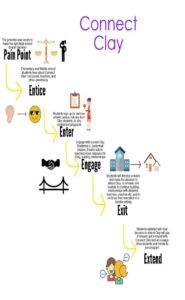
Author: Faisal
Gallery Day Summary
Date: March 8, 2017
Location: Stayer Center
Time: 9:30 am
It was a great morning with cinnamon bagels, coffee, and great company. It was really enjoyable to see everything come together on the board: our journey map, the user interviews, the expert interviews, the analogous immersions, the ethnographic research etc. I started to see the great benefits the design thinking and the sticky notes. It really helps to see patterns in the research that we’ve done and the information we have gathered from different sources.
We started with the journey map. Entice, Engage, Enter, Exit, and Extend. The key takeaway from Entice is that we need to figure out how to attract students from all of the middle schools. There is currently no academic advertising, it seems that SBSC only allows them to advertise the Arts magnet. We need to figure out the rules pertaining to this issue. In terms of Engage, discipline is one of the big issues. Our clients pointed out that we need to figure out how to flip the high expulsion rate from a negative to a positive. We need to show that it is a no-nonsense school that one can feel safe at and concentrate on their studies. The building itself is old and doesn’t look the best. Given the fact that it is an Arts magnet, we can leverage the skills of the students to spruce the school up a little with murals and paintings around the school. Painting the lockers to a brighter color could make a big difference as well. The extend step is also key because we need to be able to show the success of the students that have graduated from Clay. We need to show that they have gone on to good colleges or good jobs. We need to connect these graduates back to the community and middle schools to encourage students to go to Clay. Word of mouth is key. If people look at Clay in a positive light as a place that equipped and helped their role models become who they are, it will encourage more students to attend Clay in order to emulate them.
While working through the journey map we were able to make connections to the users and their various characteristics. Sophia, for example, is very interested in Arts, yet she chose to go to Adams high school because of the IB program. Additionally, we were able to see from Maria McKenna that she was concerned about safety, high expectations, and keeping their kids involved/out of trouble. We were able to see that Clay has a lot to offer we just need to figure out a way to show everyone that and advertise to the middle schools and parents in a target manner. We need statistics for those that would like statistics, we need simple and to the point advertisements for those that desire that, we need to potentially translate some materials for those that speak a different language, we need simple language for those that might not have gone to college. We need to work on student-teacher relations and ensuring that students feel supported and cared for.
It was really insightful to have Principal Eid and the English teacher there to see all of the research that we have put in and give us their feedback. They did a good job of directing us and keeping us focused by asking, “What does this mean? Or, so what?” Oftentimes, we didn’t have the answers to their questions, but it means we need to do more research and legwork. But I think it was really cool to show them that Clay is a good school. As Professor McKenna said, it is “South Bend’s best kept secret.” I think it made them happy to see that and gave them hope. But there are difficult questions like the reputation and word of mouth that need to be answered and solved that will take time. It will take time for the word of mouth to spread for the eldest children in some families to attend Clay and for their younger siblings to follow. It will take time to re-establish the reputation of Clay in the middle schools and with the parents. We need people to be proud of Clay for it to have an identity. It is not second fiddle to Adams or Penn, it is Clay and its a great place for a student to learn in its own right.
Immersion in Clay High School
10 February 2017
Visit/Tour of Clay High School
Location: Clay High School
Time: 8-10 am
Participants: Clay Team A and Team B, Principal Eid
After parking my car in the main parking lot, I walked in through the main door. From the outside, Clay looks like a normal high school, a little old but still in decent condition. After signing in with security, I make my way to the principal’s office. The hallways are lined with plaques, trophies, and artwork, reminiscent of my old high school. We sit down in Principal Eid’s office and discuss the history of Clay, our goals, and Principal Eid’s goals for the project. During this time, we are given a lot of literature on the South Bend Community School Corporation, the various high schools and middle schools. We get numbers on AP/dual class offerings and enrollment. We then are guided on a tour of the school by Principal Eid himself. It is clear that the Arts are a big part of the school as it is an Arts magnet. But another key part of the school is the slate of CTE courses available for those that want to enter the workforce out of high school. The CTE courses include welding, culinary arts, auto mechanic instruction, CNA, EMTN.
Key quotes:
“Penn receives 11,000 dollars per student whereas we only get 6,600 per student because of property taxes”
“The voucher system hit the public schools hard”
“The corporation has been losing between 300-500 kids per year, where are those kids going?”
“There is brain drain towards Adams”
“Once bussing started and Clay was no longer a neighborhood school, the demographics changed. You started to see more diversity. You also started to see more gang affiliation”
“We used to have 4-5 fights a day…gangs taking over parts of the school. There was an intersection that teachers used to avoid at all costs. In my first week I expelled 22 students for gang affiliation and destruction of environment. I was trying to set the tone”
“There was a surge of 773, 312 area codes from Chicago. We were inheriting poverty from another state”
“Right now we are at a student body of 1143. Ideally, I’d like us to be at 1400”
“Lasalle has all the smartypants and most of them end up going to Adams”
“Every morning, I watch 80 of the smartest students get bussed to Adams that are from our(Clay) district.”
Big issue
Clay has a reputation that precedes itself: poor, diverse, not where high achieving students go. Adams is seen as the crown jewel of the SBSC by the school board, the community, the parents, and the students in middle school. How do you make Clay a place where ALL students want to go because it is a good school on a number of fronts. It has strong academics(AP classes, good teachers will prepare you for college), good arts(for those that are interested, supplements and improves learning in other subjects like math and science), it is safe, it will push students to their potential, it has good athletics(something to be proud of and compete in), it has a good community(where one can feel supported and cared about).

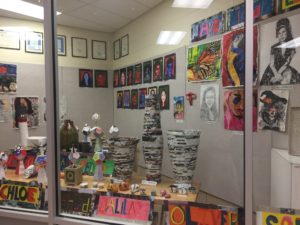
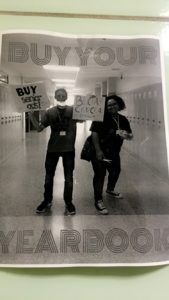
3 Key takeways
- Clay is dealing with a vastly different socioeconomic demographic than Penn, many students on free and reduced lunch. This also means that there are fewer financial resources for the school to work with.
- Clay used to/still does have the reputation of being the “thug” school. Lots of fights, poorer demographic.
- Clay has tried to improve itself by getting more AP classes, CTE class offerings, increasing safety.
Workarounds
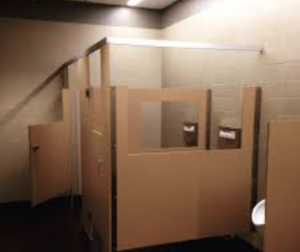
Seattle Convention Center:
Bathroom stalls have cutouts in order to prevent people from shooting up in the bathrooms.

Everywhere around Seattle from public places outside to bathrooms in grocery stores I noticed these needle drop-boxes. From my knowledge on public health, the idea seems to be that the government is accepting that no matter what rules and regulations are in place, people might abuse drugs. Given that, the government is trying to minimize the spread of disease because of needle sharing.
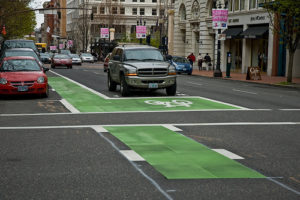
In Portland, they were trying to reduce fossil fuel emissions. In order to do so, they aimed to reduce the number of people using automobiles for transportation. The workaround here was to paint some of the road green for a designated bike lane. According to my friend, this significantly reduced the number of car commuters.
Ethnographic Research: Photo Journal
Date: March 3, 2017
Location: Clay High SchoolUsers: Student Volunteers at Clay High School
Conducted by Faisal Shariff
Escorted by Principal Eid, I went into various classrooms around the school and made a two minute announcement regarding my photo journal. I had notecards with instructions written on them and my email address and phone number for the students to send their photos to. The instructions were to take 5-10 pictures of their favorite things about Clay. I tried to leave it open ended. My hope was to get picture of people, places, and interesting objects.
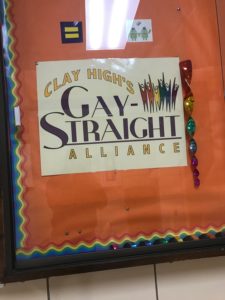
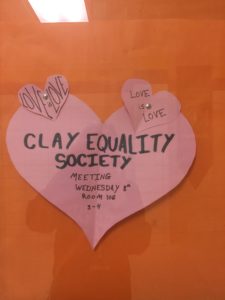
In our experience walking around the school, talking to students, teachers, and administrators, it seems that there is a very welcoming community for people who identify as LGBTQ. Most recently, there was a play with an LGBTQ character. In our survey research, we also found that a number of students listed this community and support specific to LGBTQ issues as a reason for coming to Clay.


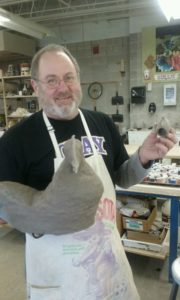
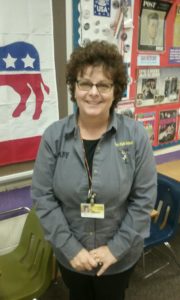
It is clear that there is a lot of love for the teachers at this school.
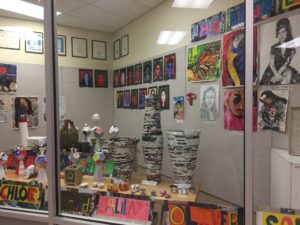
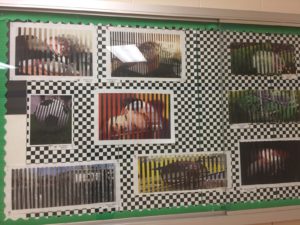
An art showcase in the main hallway. As the Arts magnet, Clay attracts many talented students and they produce beautiful work. It is a core part of this school’s identity.
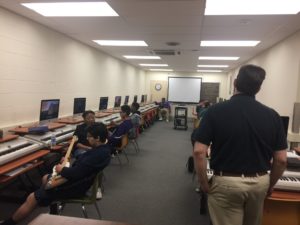
Classroom with piano keyboards. The class was learning how to produce music electronically. They first try to add small beats to the background of existing tracks and then they proceed to producing their own music.

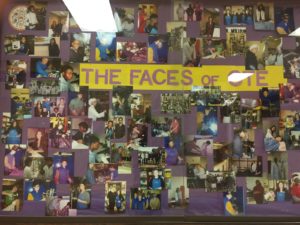
The Dual credit program and the CTE(Career and Technical Education) classes. This program is extremely valuable at a high school because not everyone has a desire to pursue further education. Some people want to enter the workforce immediately. The programs in Clay are listed below. Some notable ones are Automotive technology,
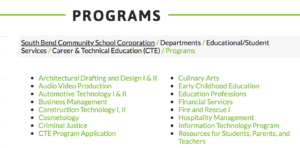
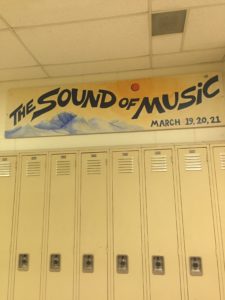
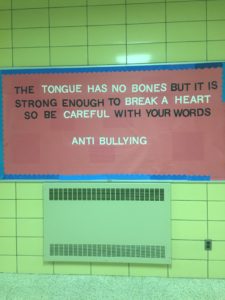
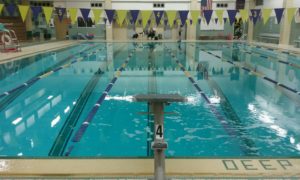

The Sports facilities. What is notable is that athletics are not as prominent. Students from the survey and card sort research did not list athletics very highly.
Below is a video of me walking through Clay through the eyes of Snapchat.
Interview 9 – Parent Interview: Mrs. Mirza
Date: March 3, 2017
Location: Mirza Residence
Interview type: Interactive
Team Participants: Interview conducted by Faisal individually.
User characteristics:
- Married, mother of three boys ages 14, 16, 19
- College educated
- Runs a bed and breakfast
- Husband is professor at University of Notre Dame
- When and How did you come to the decision on which high school to send your children?
- Discussed it as a family
- Looked at what each school had to offer. We had heard about Penn, so there was the option to go back to that. But we had a few reasons to try something different. We were deciding between Clay, Adams, Riley, Washington, and St. Joe. We made the decision on public school partly because of the cost factor, and they had attended public school in California and we had a good experience with it.
- Adams stuck out because of the IB program and its diversity. Penn was large but didn’t really have competition in the district because its only one high school. We thought it might be difficult to get into certain classes. We had heard good things about Adams from Notre Dame faculty that my husband worked with.
- The sports program at Adams was good for cross country and track. It was competitive and that was important to Momin.
- Additionally, Adams had good extracurricular programs in Model UN, Mock Trial and those things were important to Momin’s little brother Sami.
- We felt that the IB program was well-rounded, challenging, and good preparation for college.
- To be honest, for Clay, it was a minor thing, but the “Colonials” mascot kind of turned us off.
- One thing we kept in mind was that test scores and numbers could be misleading with regard to the quality of the school in the sense that Penn is a very good academically but it is feeding a very specific demographic and is therefore not as diverse because it is predominantly white and middle class.
- We wanted them to be exposed to more diversity. You learn life lessons from people who don’t think like you or believe the same things that you do.
- How did you do your research?
- My husband did a lot of the groundwork on the internet. He surfed the school’s websites to see what options they had.. where the district boundaries were and what schools served what neighborhood. Mom used athleticnet.com to look into the track timings of the high schools in the area to see where he could fit in and be competitive. After we were kind of settled on Adams, I made a few phone calls to the IB director to get other logistical things figured out.
- How do you feel now?
- Happy with the decision to send them to Adams. Moving was difficult, obviously. But I don’t think I regret not sending them to Penn or another place.
Interview 7 – Student Interview: Momin Mirza

Momin Mirza
Date: March 3, 207
Type: Interactive Interview
Location: Momin’s house
Interviewer: Faisal Shariff
Video Recording
User Characteristics:
Male
Junior at Adams High School
Athlete: Track and Cross Country
Father is Professor of Islamic Studies at Notre Dame
Lives in South Bend, IN
Used to live in Granger earlier in childhood. Family moved to Berkley for 5-6 years, and now moved back to South Bend.
Who is Momin?
Momin is a smart, driven, athletic individual. Academics are important to him. He wants to do well in the classroom and be challenged but he also wants to compete at a high level in track and cross country.
What made the difference?
I think that if Clay’s athletic teams were stronger than Momin might have been more inclined to attend Clay.
- How have you liked Adams?
- It was an adjustment moving from Berkley and joining at the beginning of my junior year. It is academically challenging. The IB program especially, there are a lot of guidelines and you have to express your ideas well. The track and cross country teams have been welcoming.
- What made you decide to come to Adams?
- I was choosing between Penn, St. Joe, Clay, Marian, Adams, Riley. IT came down to Adams and Riley. The academics were important and sports were also important to me. I ran cross country in California and was looking for a similar level of competition and team that would push me to improve.
- Some of the decision was based on the fact that IB diploma would look best to colleges
- I used the internet and visited the school websites to see what the campuses were like. I also looked up the timings of the track team to see where I would fit in.
- Proximity of the school to our home and my dad’s work was also something considered.
- Why not Clay?
- Sports teams were lacking, and academics were not as rigorous from what I heard, but one minor thing was my parents didn’t appreciate the mascot being the colonials.
- Imagine for a second that you had lived in the same place for your childhood and had to come to a decision regarding high school choice, how would things be different?
- I think that I would have more friends that are knowledgeable. I would have talked to them more and gotten a better understanding of the school in the area.
- Talk a little bit about diversity and how important it is to you.
- It was a concern of mine. Especially coming from Berkley where I was surrounded by such diversity coming to more conservative Indiana. I felt that Adams was going to be very diverse.
- Did you ever take into consideration the arts when making your decision?
- Not really interested in the Arts
Key quotes:
“Some of the decision was based on the fact that IB diploma would look best to colleges”
“At Clay the sports teams were lacking and the academics were not as rigorous from what I had heard”
Personal Immersion: High School Choice Faisal Shariff
Faisal Shariff
Age: 21
Hometown: Granger, IN
Senior Science-Business major, Poverty Studies minor
Middle School: Private – The Montessori Academy at Edison Lakes
When choosing a high school to attend, my parents and I did quite a bit of exploration of both the public and private schools in the area. I shadowed at Adams and Trinity while taking a tour of St. Joe and Penn. My parents wanted an academically rigorous school that would prepare me for college. But they also wanted a school with diversity and a decently-sized student body. My middle school had a graduating class of ten. Clay was an option as well but never really under serious consideration.
Adams seemed like the logical choice in South Bend given the IB program. I had a lot of friends from my middle school who were Adams-bound. The school felt diverse, the mock trial team was known to be amazing. I had heard about one teacher, Mr. Longenecker, a science teacher who was supposed to be phenomenal.
Trinity is a small catholic private school. It wasn’t particularly diverse. But we had friends that were enrolled at the school and had heard good things about it. It was clear that the students got lot of individual attention. I think I didn’t end up choosing Trinity because I wanted something different from my middle school experience.
St. Joseph also seemed like a good option with rigorous academics and a strong science program. It had a medium sized student body. It wasn’t particularly diverse socioeconomically given that it was a private school. This turned my parents off a bit I believe.
Penn: People call this school, Penn University because it has a student body of 3,600 students. This fact could be intimidating but also a taste of the real world and could provide an enriching environment to learn in from people with different backgrounds. It has a plethora of resources and countless activities and clubs. Additionally, it is known to be pretty competitive. This school was also in my district.
In the end, I think academic rigor was the priority along with safety and a rich learning environment. Penn, St. Joe and Adams were the finalists. I think we realized that we could get as good of an education at public schools so it might not be necessary to pay the high private school tuition, even though my family is financially stable. Further, with Penn being in my district, transportation wouldn’t be a big issue. We did go against the grain a bit in terms of not listening to peer-reviews of the high school, however, which is unique from most situations according to the literature.
Interview 8 – Expert Interview: Professor Maria McKenna
Date: March 3, 2017
Type: Expert Interview
Location: Phone Interview
Expert: Dr. Maria McKenna
Expert/User Characteristics:
- Senior Associate Director of Education, Schooling, and Society.
- Assistant Professor of the Practice for Education, Schooling, and Society and the Department of Africana Studies. She is also a Faculty Fellow with the Institute for Educational Initiatives at the University of Notre Dame.
- Married, mother of four, two children in High School at Adams
- PhD
- Mother
http://iei.nd.edu/people/iei-fellows/maria-mckenna/
Faisal Shariff interviewed Dr. Maria McKenna on the phone.
Faisal: What factors do you think most parents consider when making a high school choice? Is a choice made or is it assumed?
Professor Maria McKenna: “First of all, I don’t think you can think about this situation from a deficit-minded perspective. Parents are working with whatever knowledge they have..the history of South Bend and their own children. You have to assume that every parent is trying to make the best decision for their child with the information that they have available.
The decision-making process has to do a great deal with the information they have available. Parents will tell you that they want a school that’s safe, that is going to push their child-this will be said in a lot of different ways: “rigorous, a place with high expectations, make him do his work, pushing child to be best C
of themselves”
- Safety
- High Expectations/Rigor
- Programs to keep students busy/out of trouble
Literature on school choice says that parents choose schools based on word of mouth and what friends say.
“Choosing a school in South Bend is like a game of telephone”
F: What do you know about Clay High school?
MM:
- “Its a vibrant viable school not just for the arts but for students also interested in AP courses and the AP track to allow them to earn dual credit”
- “School in what many people would say is a pretty stable neighborhood”
- “School with enormous potential to own its identity”
- “As someone who does a lot of research on schools, and school choice, I was equally impressed with Clay as with Adams when talking with guidance counsellors and school leaders. What’s striking is how much I might not have known if I had not reached out and called the guidance office.”
“Parents who are pleased with the program are the best mechanism for bringing people into the door that you have”
F: What do you personally consider as a parent?
MM: “Three things. Strong leadership- a visionary leader at the front, you walk into the building and feel like they are gonna care about my kid and know who they are. When you walk around the school, you see teachers laughing and joking around with each other versus disciplining them. Third, whatever academic institution it is, I want it to be academically rigorous. When we were choosing, we let the kids pick with a little bit of coaching. But if I had a choice, I would have put them in clay. It was the most impressive in terms of the full package – arts, athletics, caring community, and dual credits. My kids chose something different because their friends chose something different, which we respected and were fine with.
- “Clay is underselling itself”
- “Clay is one of the best kept secrets in south bend, and we need to crack open the nut and not have it be a secret”
What do we need?
- The thing that I have that other parents might not is the access and wherewithal to get information. Others don’t have the same social capital or networking potential.
Thoughts on South Ben School Corporation
- South Bend has to sell diversity as a strength
- Clay needs to stop being afraid, and need to stop trying to be like adams
- Play up the fact that its an arts institution
- “Parents need to know where there are safe places for there kids to be that are diverse”
- Demographics of South Bend: 70% on free/reduced unch
- More than 60% are students of color
- “Clay is a unique and proud place for children to grow”
- “Need to play up the fact that they have dual credit program to the parents who do have the option to pay for private schools”
Thoughts on how to reach out to parents, students, recruitment
- Need to realize that some of the parents are not high school graduates or are English language learners
- Tailor the print materials to that
- Readability of actual text
- Key talking points that parents can walk away and remember
- Ex: That’s how Trump won. He had a clear, concise, defined message
Key takeways
- Assume that every parent is making their best effort to equip their children to succeed.
- Clay is not second fiddle to Adams. It is a good school with a lot to offer academically, extracurricularly, diversity-wise, and with the arts. It has a good community and would be a great place for a student to learn and grow.
- Understand your target. Target all of the middle schools in the SBSC. Clay needs to build the reputation of the school where all those students want to go.
Key quotes:
“You have to assume that every parent is trying to make the best decision for their child with the information that they have available.”
“Parents pick schools based on word of mouth, based on what their friends say”
“Choosing a school in South Bend is like a game of telephone”
“Have to figure out a way to get information out into all pockets of the community to show them what Clay is about”
“Parents who are pleased with the program are the best mechanism for bringing people into the door that you’ve got”
“Clay is underselling itself. Clay is one of the best kept secrets in South Bend”
“Learn a lesson in precision and concise thinking from Trump and this most recent election”